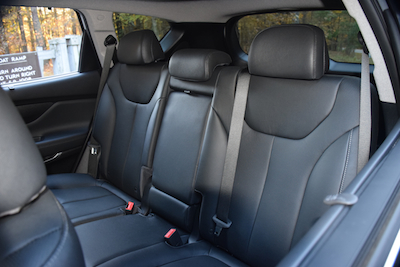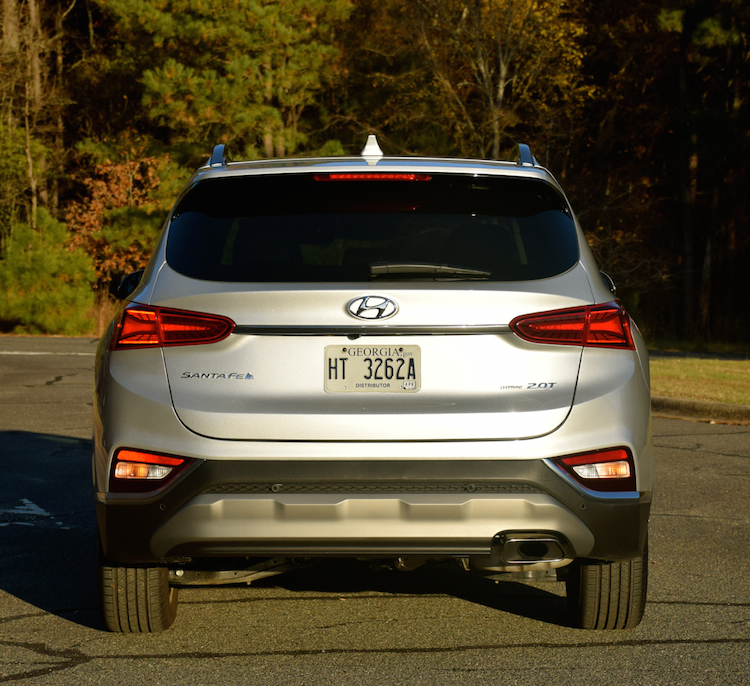Hyundai’s midsize SUV is all-new for 2019.
The 2019 Hyundai Santa Fe is all-new and now represents a two-row midsize crossover utility vehicle with room for five. Whatever happened to the three-row version? It is still around, but Hyundai renamed it the Santa Fe XL for 2019.
Hyundai Utility Vehicle Primer
So, what’s in a name when it comes to midsize Hyundai SUVs? We’ll explain as follows:
- The 2018 Hyundai Santa Fe Sport (5 passengers) was replaced by the all-new 2019 Hyundai Santa Fe (5 passengers).
- The 2018 Hyundai Santa Fe (7 passengers) was renamed the Hyundai Santa Fe XL (7 passengers) for 2019. Importantly, it is based on the previous-generation model.
- Beginning in 2020, the all-new Hyundai Palisade (7/8 passengers) will replace the Santa Fe XL.
- Thus, starting in 2020, Hyundai’s four-strong utility vehicle lineup will comprise the Kona (subcompact), Tucson (compact), Santa Fe (midsize, two rows), and the Palisade (midsize, three rows) models. In effect, Hyundai serves every important crossover segment with this four-model SUV line.
- The Santa Fe’s competitive set includes the Ford Edge, Nissan Murano, and the Chevrolet Blazer.
2019 Hyundai Santa Fe Review
Our review focuses exclusively on the 2019 Hyundai Santa Fe, a model that launches this nameplate’s fourth generation.
Hyundai offers this model in seven trims: SE 2.4 ($25,500), SEL 2.4 ($27,600), SEL Plus 2.4 ($29,800), Limited 2.4 ($32,600), Ultimate 2.4 ($35,450), Limited 2.0T ($34,200), and Ultimate 2.0T ($37,100). Add $980 for the required destination fee and $1,700 for optional all-wheel drive.
This may seem like a lot of trims for a model, but in reality, there are five as each Ultimate and Limited version is differentiated by engine choice alone. Furthermore, there are no packages available as each trim includes various equipment upgrades.
Design Highlights
The all-new Santa Fe is slightly larger and weighs somewhat less than the previous model. You aren’t likely to detect the size differences as passenger volume is roughly equal to the earlier model. Cargo space is also about the same.
As for the Santa Fe’s design, it reflects a new look that launched with the Kona in 2018. There are some differences, but both models have narrow “slit-eye” LED lights and a trapezoidal grille. The Santa Fe also incorporates stacked headlamps and has a sizable lower air intake.
The Santa Fe’s profile now has a more formal look. Where the previous model’s beltline rises dramatically at the rear door handles, the new model rises only slightly before meeting the roof line.
The same can be said for the upper character line, which now runs the entire length of the SUV from the front of the hood to the taillights. From the rear, the Santa Fe benefits from new LED lights, which are in my opinion more elegant than the previous ones.
Standard equipment includes projector headlights, high beam assist, LED daytime running lights, power-heated and -folding side mirrors, and 17-inch alloy wheels. Upgrades include LED headlights and taillights, fog lights, a panoramic sunroof, and 18- or 19-inch alloy wheels.
Inside, the 2019 Santa Fe has a “class above” look with its handsome materials and excellent fit and finish. The sculpted dashboard looks expensive, a design that’s evenly split between driver and passenger. The color display sits on top of the dashboard above the center stack, ensuring a clean and uncluttered look.
There is ample room for five inside, with rear-seated passengers finding plenty of legroom, thanks to about two extra inches between the wheels. Of course, the best seats in this SUV are up front with both offering generous back, hip and thigh support.
All models come with a tilt-and-telescopic steering column, full power accessories, and air conditioning. Dual-zone climate control rolls out at the SEL Plus level. Cloth seats are standard and heated front seats are included except with the base trim.
Power front seats are included beginning with the SEL trim. Ventilated front seats and heated outboard rear seats are offered with the Ultimate model only.
Safety & Technology
Manufacturers are adding more driver-assist safety features to their products and Hyundai is at the forefront of what you’ll find in standard equipment. Every 2019 Santa Fe comes with adaptive cruise control, blind spot collision avoidance assist, rear cross-traffic alert, lane keeping assist, safe exit assist, and driver attention warning.
Starting with the SEL Plus, you’ll find park distance warning and rear occupant alert. Choose the Ultimate trim and you’ll find a heads-up display and a surround view monitor.
The standard audio package is comprised of a 7-inch display screen, six speakers, Bluetooth, Apple CarPlay and Google Android Auto smartphone compatibility, and dual front and rear USB ports.
The SEL Plus model is where Hyundai rolls out a 12-speaker Infinity audio system. Blue Link connected car services start with the SEL, while the Ultimate model includes wireless device charging for supported devices and an 8-inch touchscreen with navigation.
Just to be clear, smartphone compatibility essentially rules out the need for navigation, thus its availability on the Ultimate trim only shouldn’t be viewed as a deficiency.
On the Road With the Hyundai Santa Fe
Hyundai offers customers a choice of two engines: a naturally aspirated 2.4-liter four-cylinder with 185 horsepower or a turbocharged 2.0-liter four-cylinder engine with 235 horsepower. Both engines work with an eight-speed automatic transmission.
Power for the base engine, however, may not provide enough kick for some drivers. I cannot say so for sure because that wasn’t the engine powering my Santa Fe. However, my test Ultimate model had the turbo, which supplies ample power when needed.
You’ll notice the usual turbo lag, but once fully spooled the turbo acquits itself. For the most part, the automatic transmission moves between cogs freely and without effort.
The Santa Fe’s ride quality is quite good, coming in smooth and comfortable. The cabin stays quiet at highway speeds with outside noise largely mitigated. Handling is a strong suit, making this SUV easy to maneuver in tight spaces.
Parting Thoughts
The 2019 Santa Fe gets the job done, especially when equipped with the available turbo engine. But all three competitors have stronger standard engines, which puts the Santa Fe at a performance disadvantage.
Like other Hyundai models, the Santa Fe offers generous standard equipment, a competitive price point, and a robust warranty plan. This combination gives Hyundai an advantage, something consumers should keep in mind when shopping for a midsize, two-row crossover utility vehicle.
|
See Also – Crossing Over With the 2018 Hyundai Santa Fe
Photos copyright Auto Trends Magazine. All rights reserved.
- 2024 Mazda CX-50: A Compact SUV with Premium Aspirations - Apr 15, 2024
- 2024 Ford Mustang (Iconic Pony Car Evolves) - Apr 4, 2024
- 2024 Ford Maverick (Looks Like a Truck, Drives Like a Car) - Mar 28, 2024









